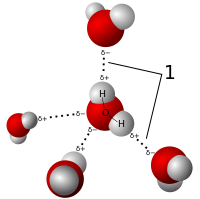
Photo from wikipedia
Abstract The structures of the silica polymorphs α-quartz and stishovite have been geometry optimized at highly simulated isotropic pressure within the framework of Density Functional Theory. The atoms of the… Click to show full abstract
Abstract The structures of the silica polymorphs α-quartz and stishovite have been geometry optimized at highly simulated isotropic pressure within the framework of Density Functional Theory. The atoms of the high-pressure polymorph stishovite are virtually incompressible with the bonded radii for Si and O atoms decreasing by only 0.04 and 0.08 Å, respectively, at 100 GPa. In compensating for the increase in the effective interatomic potential associated with the compression of the Si-O bonded interactions, the electron density at the bond critical point between the bonded pair increases from 0.69 to 0.89 e/ Å3. The bonded radii of the Si and O atoms for α-quartz decrease by 0.006 and 0.008 Å, respectively, between 1 bar and 26.4 GPa. The impact of simulated, isotropic pressure on the bonded radii of the atoms for three perovskites YAlO3, LaAlO3, and CaSnO3 was also examined at high pressure. For the YAlO3 perovskite, the bonded radii for Y and Al decrease by 0.06 and 0.05 Å, respectively, at 80 GPa, while the electron density between the bonded atoms increases by 0.12 and 0.15 e/Å3, on average. The calculations also show that the coordination number of the Y atom increases from 9 to 10 while the coordination number of the O1 atom increases concomitantly in the structure from 5 to 6 at 20 GPa. Hence pressure not only promotes an increase in the coordination number of the metal atoms but also a necessary concomitant increase in the coordination number of the O atoms. The bonded radii, determined at a lower pressure between 0.0 and 15 GPa for LaAlO3 and CaSnO3, decrease a smaller amount with the radii for the La and Ca atoms decreasing by 0.03 and 0.04 Å, respectively, while the radii for the smaller Al and Sn atoms decrease by 0.01 and 0.02 Å, respectively. In general, O atoms are more compressible than the metal atoms, but overall the calculations demonstrate that the bonded radii for the atoms in crystals are virtually incompressible when subjected to high pressure. The reason that the bonded radii change little when subjected to high pressure is ascribed to the changes in the effective interatomic potentials that result in increased repulsion when the atoms are squeezed together.
Journal Title: American Mineralogist
Year Published: 2020
Link to full text (if available)
Share on Social Media: Sign Up to like & get
recommendations!